A true wine lover goes into apprenticeship over and over again, even at the "tender" age of his pension eligibility. There are many teachers - self-appointed and chosen gurus of wine appreciation. Emulating them has become a social game, crowned by the awareness of having guessed everything, guessed correctly and rated conformably.
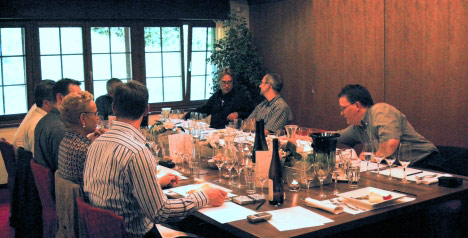
|
| A conspiratorial group takes up the work |
So I, too, often and gladly make my way to a tasting - always as a wine nose apprentice - to usually man up in one of two categories. Man? In fact, it is mainly men who expose themselves to this voluntary competition. There are women too, sure, but they are - in my experience - usually in the minority, very often just "escorts" who have to bring the bravely fighting man home safely in the car.
In my favourite category, wines and wine regions are presented that I don't know or know far too little about. There I sniff, sip, sip and spit with great pleasure: unknown worlds, new experiences, unexpected experiences. I have no trouble keeping up and keeping up, after all, they classify me as a beginner, and for beginners there is understanding, indulgence - and often the urge to come out as a teacher. It's only when it comes to scoring that I have a hard time. How should I calibrate my scale of values? I don't compare myself with my peers in the region, and squinting at the neighbour's hand - almost like in school - often brings redemption and salvation from embarrassment. But otherwise the whole thing is fun. A parlour game with new experiences and a serious background. But this becomes clear as the evening progresses and the consumption of sips takes effect.
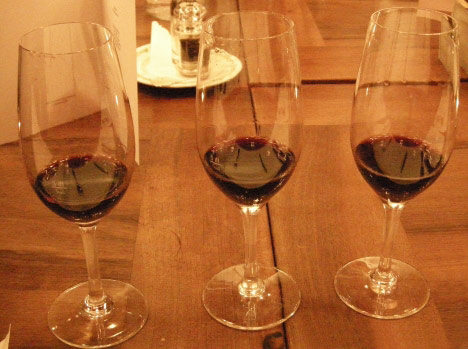
|
| The utensils: Three glasses%... |
The second category of tastings is far more demanding, a challenge, sometimes threatening the very existence of a wine connoisseur. Here, the area is "tested" in which one feels well versed, knows a lot, has read a lot and has drunk many a wine. One's own knowledge and experience are put to the test. Did you pass or fail? Have you recognised all the wines, weighted them correctly, scored them sensibly? Self-confidence often hangs by a thread!
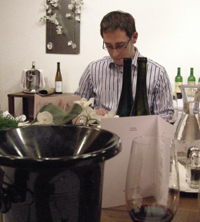
|
| Spittoon and water bottle%... |
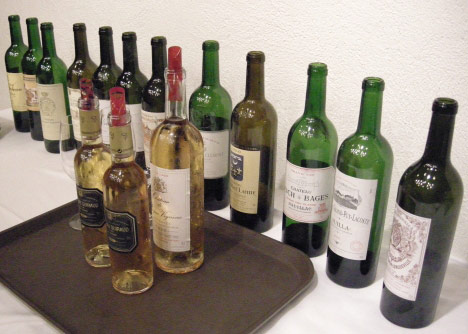
|
| twelve wines from Médoc and Graves%... |
If need be, I can save myself by looking deep into the glass, holding it against the white base and exclaiming delightedly: "still beautiful cherry red!" or - in very stubborn cases - sticking my nose deep into the glass and then proclaiming with a chest tone of conviction: "slightly wet earth, hay, cherry tones" and then delightedly: finish: "liquorice, retronasal clearly recognisable!"
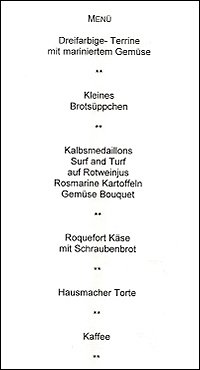
|
| and a tempting menu. |
Of course, my main concern is the twelve Bordeaux, almost all of which are also stored in my cellar, but will probably not be opened for a long time yet. I am curious: curious to know how Gruaud Larose, Léoville Poyferré and Ducru-Beaucaillou have developed in the meantime. First observation: still far too young. Then my attempt to assign the wines to the correct Château. Of course: wine no. 2 is Gruaud Larose: these exuberant aromas, mocha, even figs, which René Gabriel announced, I can detect. Wine No. 3, on the other hand, should be Ducru-Beaucaillou: full, robust, fruity, with quite a lot of tannins and truffle notes. Then no. 1 must be Poyferré: St-Julien-typical, something of the softness and warmth of a Margaux and power of Pauillac, on paper the weakest of the three wines.
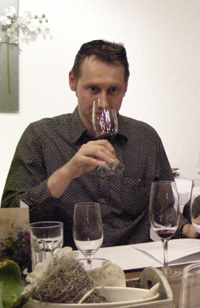
|
| I wonder what is being sniffed out with the nose? |
On to the second round! Margaux: Rauzan Ségla, Giscours, Du Tertre. Now I let go of the classification: concentrate on the points. Which is the best wine, which the weakest? And again I am statistically wrong. The "smallest" of the three wines, Du Tertre, is the most accessible, so it gets the most points from me. The Rauzan Ségla, however, is still inaccessible, but the potential is noticeable: delicate, graceful and fresh. So more points for that: I'm not bad there! I "downgraded" the totally closed Giscours with few points. Well, that's a bit better!
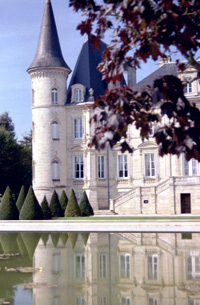
|
| Finally, there is a winner: once again Château Pichon-Longueville-Baron. |
Confidently, I start the last round. Pauillac: Pichon Baron, Lynch Bages, Grand Puy Lacoste. O miracle, almost everything right: correct classification, compliant scoring, but an opinion of my own. I find the Lynch Bages clearly better than the Lacoste and express this by half a point.
Satisfied, I can now turn to the sweet wines. I don't rank and score any more, for me it's enough to enjoy, with the quiet confidence that I can now do better in the next parlour game called tasting.
Yours sincerely, Peter
(Züllig)